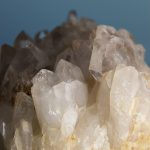Cause of Color : As per dopant used
Chemical Composition : Titanium Dioxide – TiO2
Classification / Type : The material is found abundant as inclusions (silk, needles, crystals, etc.) in number of gemstones preferably in quartz, tourmaline, ruby and sapphire but large facet table crystals are quite rare therefore gemological importance lies in the synthetic counterpart produced by flame fusion method.
Crystal System / Forms : Tetragonal System
Cuts & Uses : Facetted cuts, etc.
Dispersion : 0.290 (high fire)
Hardness : 6 - 6.5
Lustre : Vitreous
Magnification : Generally clean, strong doubling giving a hazy appearance, dispersive fire
Optic Character : Anisotropic, D.R.; Uniaxial Positive
Pleochroism : Weak
Refractive Index / Birefringence : 2.616 – 2.903 / 0.287
Simulants (with separation tests) : G.G.G. (dispersion, doubling, S.G.), Y.A.G. (dispersion, doubling), Synthetic Cubic Zirconia (S.G., dispersion, doubling), Diamond (dispersion, doubling), Strontium Titanate (dispersion, doubling), Sphene (doubling, dispersion, inclusions), Zircon (dispersion, spectrum), etc.
Specific Tests : Very high doubling and dispersive fire.
Spectrum : Not diagnostic
Synthesis : Flame Fusion Method




























Leave a Reply
You must be logged in to post a comment.